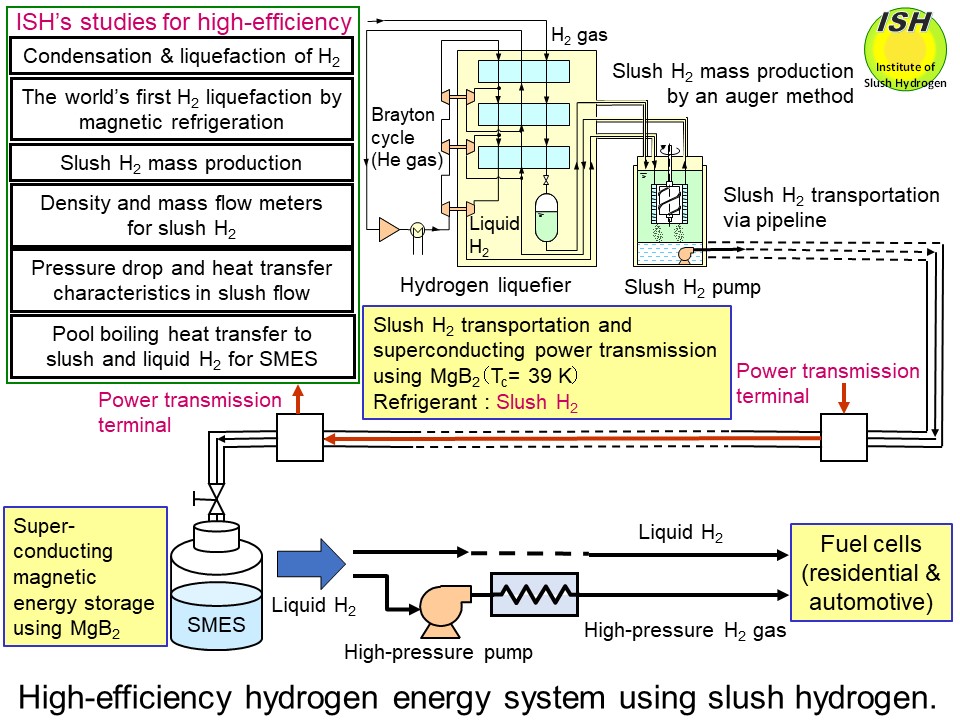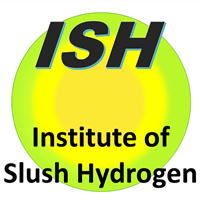Development of the high-efficiency hydrogen energy system using slush hydrogen

Anticipated applications for slush hydrogen include fuel cells, rocket
and space-plane fuels, and refrigerant for high-temperature superconducting
(HTS) equipment. With the rapid popularization of fuel cells, increasing
demand for electrical power due to the rise of information technology,
and the need to reduce greenhouse gas emissions [1, 2]*, Institute of Slush Hydrogen (ISH) has originally proposed the high-efficiency
hydrogen energy system using slush hydrogen, and has been engaged in related technological development work as illustrated
in the above figure [3-5].
When hydrogen is transported in the form of slush through long-distance
pipelines, in combination with the HTS electrical power transmission using
magnesium diboride (MgB2, Tc = 39 K), and the high-temperature superconducting magnetic energy storage
(SMES) at the terminal with liquid (20 K) or slush hydrogen (14 K) as the
refrigerant, both fuel and electrical power can be simultaneously transported and stored
with synergistic effect.
To bring about the practical realization of this hydrogen energy system,
ISH has been engaged in research and development work as indicated in the upper left corner of the figure.
-
The world's first verifiation of agreement of condensation heat transfer to hydrogen with the Nusselt theory [6-8],
-
The world’s first demonstration of the high-efficiency hydrogen liquefaction using magnetic refrigeration [11, 12],
-
Demonstration of the mass production technology of slush hydrogen using an auger method [13, 14],
-
Research and development of high-accuracy density and mass flow meters for slush hydrogen with an innovative structure, considering the behavior of solid particles [15-21]; measurement accuracies of 0.5% and 0.25% in density for slush hydrogen and slush nitrogen, respectively [26, 31],
-
The world's first demonstration of the simultaneous occurrence of pressure drop reduction and heat transfer deterioration in slush nitrogen flow for various types of pipe such as circular, square and triangular pipies (the Reynolds' analogy), and the pressure drop reduction in slush nitrogen flow for corrugated, converging-diverging and elbow pipes [22-31], and the development of a three-dimensional numerical simulation code (SLUSH-3D) to clarify flow and heat-transfer characteristics in slush hydrogen and slush nitrogen flows [31-34], and
- Pool boiling heat transfer to slush and liquid hydrogen for the high-temperature
SMES [35, 36].
* Numbers in the bracket show the numbered references in "References".
Message from Representative
Efforts are currently underway in Europe, North America, and Asia aimed at the realization of hydrogen energy society, including household fuel cells, fuel cell vehicles, and the full-scale spread of the infrastructure network of hydrogen stations for fuel cell vehicles.In Japan, sales of the world’s first fuel cell cogeneration system for household use (ENEFARM) began in 2009. General sales of fuel cell vehicles (TOYOTA MIRAI) began in 2014, with full-scale popularization envisioned for 2030.Considering the world’s trend for realizing the hydrogen energy society, with the objective of practical realization of this high-efficiency hydrogen energy system, Institute of Slush Hydrogen is carrying out the research and development work associated with slush hydrogen.
